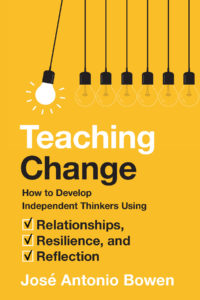An exploration of the difficulty of human learning, especially the ability to change your mind. Teaching Change makes a powerful argument as to how a new 3Rs of relationships, resilience and reflection can better prepare graduates for an uncertain future. Elegant and gripping explanations of recent and wide-ranging research from biology, economics, education, and neuroscience are paired with hundreds of practical suggestions for individual teachers.
ORDER at Johns Hopkins University Press and get 30% off with the Code: HTWN or ORDER at Amazon

Learning something new—particularly something that might change your mind—is much more difficult than most teachers think. Because people think with their emotions and are influenced by their communities and social groups, humans tend to ignore new information unless it fits their existing worldview. Thus facts alone, even if discussed in detail, typically fail to open minds and create change. In a world in need of graduates who can adapt to new information and situations, we need to renew our educational commitment to producing flexible and independent thinkers.
In Teaching Change, José Antonio Bowen argues that education needs to be redesigned to take into account how human thinking, behaviors, bias, and change really work. Drawing on new research, Bowen explores how we can create better conditions for learning that focus less on teachers and content and more on students and process. He also examines student psychology, history, assumptions, anxiety, and bias and advocates for education to focus on a new 3Rs—relationships, resilience, and reflection. Finally, he suggests explicit learning designs to foster the ability to think for yourself.
The case for a liberal (by which Bowen means liberating) education has never been stronger, but, he says, it needs to be redesigned to achieve the goal of creating lifelong learners and citizens capable of divergent and independent thinking. With an expansive and powerful argument, Teaching Change combines elegant and gripping explanations of recent and wide-ranging research from biology, economics, education, and neuroscience with hundreds of practical suggestions for individual teachers.
Table of Contents Outline (with word counts)
Acknowledgements (1,600)
Introduction (2,100 words)
PART 1: Change and Learning
1: Educating for Uncertainty (9,500)
Why we need to prepare students to self-direct their own change and future learning for knowledge that has not been discovered and for jobs that do not yet exist.
2. Your Brain-Closet (7,100)
Your brain stores information like you store shoes in your closet, organized by categories that are unique to you.
3. Aiming Your Flashlight (7,700)
Emotions direct how your brain directs its limited amount of attention to retrieve information from your brain-closet.
4. The Difficulty of Thinking for Yourself (9,600)
Content fails to change minds because we think socially; changing minds means changing friends.
5. The Difficulty of Thinking with Others (And Why Discussion Can Fail) (8,700)
Group discussion is a cornerstone of education, but educators often fail to understand what lawyers, politicians and psychologists know about the power and dynamics of “group think.”
PART 2: A New 3Rs
6. Relationships (11,800)
We can subvert the brain’s threat response to new information and change lives with trust, a sense of belonging and a shift from “professor” to cognitive coach.
7. Resilience (14,000)
The research on mindset, character, self-control, motivation, grit, and self-efficacy can help us increase student perseverance and comfort with discomfort.
8. Reflection (11,900)
Mindfulness, meta-cognition and reflection are essential for integrating knowledge and bringing students to guide their own learning.
PART 3: Learning to Change
9. Driving Change (10,000)
Motivation, meaning and behavior can each drive change but sustainable change requires the alignment of all three.
10. Teaching Change (9,500)
We can teach independent thinking and design for change better when we understand how to overcome the barriers to change.
11. Designing Change (11,500)
How can we reimagine education for the brain in the body using the new 3Rs and this understanding of the difficulty of change?
Endnotes (indexed to ref list and included in chapter word count)
Reference List (45,000)
Index
